
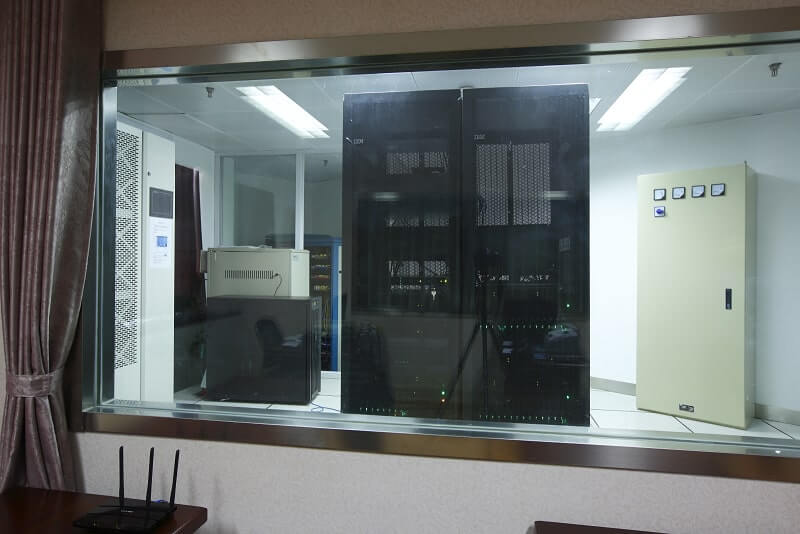
1. High-performance computing cluster
The cluster uses IBM BladeCenter H Blade Centre and HS22 as the computing node, with a total of 37 nodes, 444 cores, 26T storage space, capable of 40GB Infiniband high-speed full interconnect.
Base compilation environment for the cluster.
gcc/g++/gfortran
Intel Compiler v11.1 /MKL (non-commercial edition)
NetCDF 4.1.1 (compiled with icc/ifort)
MPI environments (all support Infiniband networks)
OpenMPI 1.6.2 (compiled with icc/ifort)
mvapich2-1.8 (compiled with icc/ifort)
Software currently running on the cluster:
ANSYS, Matlab, Delft3D, EFDC, NHWAVE, SELFE, ELCIRC, WWM, POLCOMS, POP3, GOTM, HOS, OpenFOAM, and others.
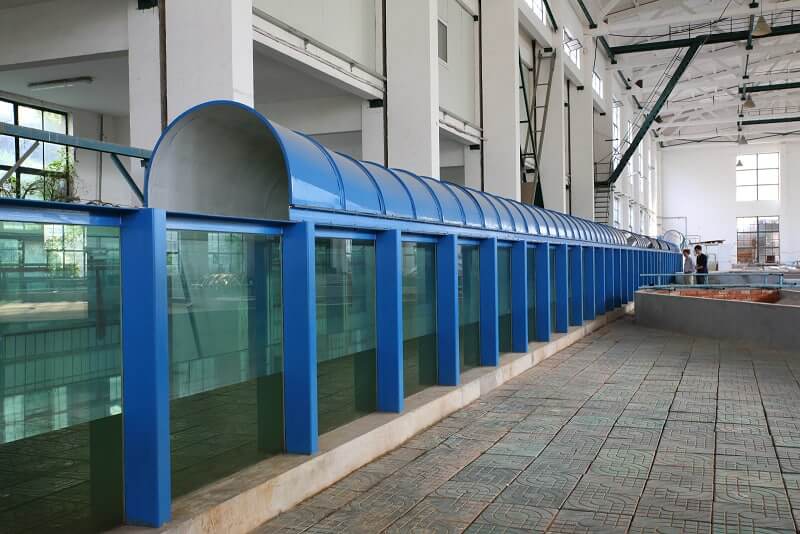
2. Wind and wave current flume
Experimental Centre has a total of 4 irregular wave test tanks, the new construction of the wind and wave flow flume dimensions of 85m long × 1.0m wide × 1.5m high, equipped with a servo-motor-type tank with a secondary reflective wave full-absorption device irregular wave wave wave making system, circulating water flow system, wind system, can simulate the maximum wave height of 0.3m, the wave period of 0.5s ~ 5s of the irregular waves, the simulation of the maximum flow velocity of 0.5m / s ( 0.5m water depth), maximum wind speed 15m/s, the total cost of the wind and wave water tank system 2.02 million yuan, can carry out the physical model test under the joint or separate action of wind, waves and currents, with the ability to study the various dynamic response mechanisms of offshore buildings under the action of two-dimensional irregular waves and the interaction between the waves and the buildings in coastal engineering and the ability of the key technical and theoretical issues.
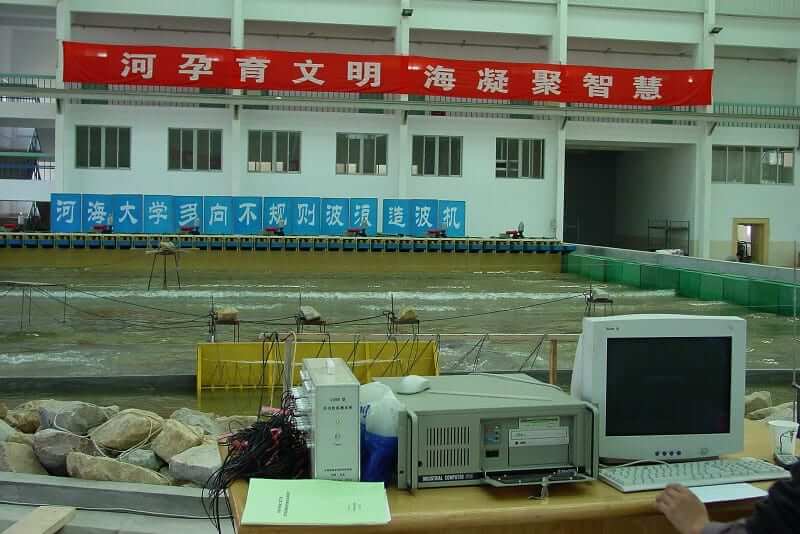
3. Comprehensive experimental harbour and measurement and control equipment
Existing experimental harbour pool, the size of 60m long × 39m wide × 1.3m deep, equipped with multi-directional irregular wave making machine (serpentine-type wave making machine) system, wave making machine system at a total cost of 2,420,000 yuan, a total of 84 pieces of width of 40cm × height of 80cm independent of the push plate, the push plate stroke ± 30cm, a total width of 33.6m, can simulate the wave period of 0.5s ~ 2.5s, the range of wave direction of 0 ~ ± 30 °, maximum wave height of 0.2m irregular waves. The harbour basin is also equipped with DJ-800 multi-parameter wave test measurement system, wave pressure and total force instrument, ship impact force bollard force measurement system, six-component instrument, harbour basin video monitoring system, large-span electric measurement bridge and other measurement equipment. The harbour basin has the ability to undertake the overall wave modeling research for harbour, coastal and offshore projects.
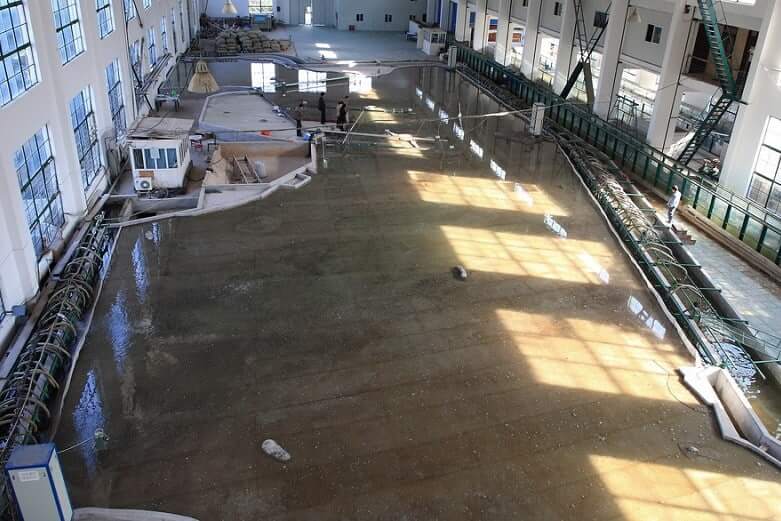
4. Open boundary multi-pump control trend simulation system
The system consists of a number of 32-channel open-boundary model multi-pump control cabinets, hundreds of small submersible pumps, water level and flow velocity measurement equipment, industrial control computers and measurement and control software, etc., which is developed by our institute. The computer controls the operation of each small water pump (flow rate pre-calibrated) laid on the boundary of the model, which can accurately simulate the flow rate size, flow direction and tide level change process of the complex tidal field in the open boundary sea area. Combined with the mobile irregular wave making machine, sediment measurement and control system and other equipments, it can be used to carry out the overall physical model test to simulate the joint action of waves, tidal current and sediment.
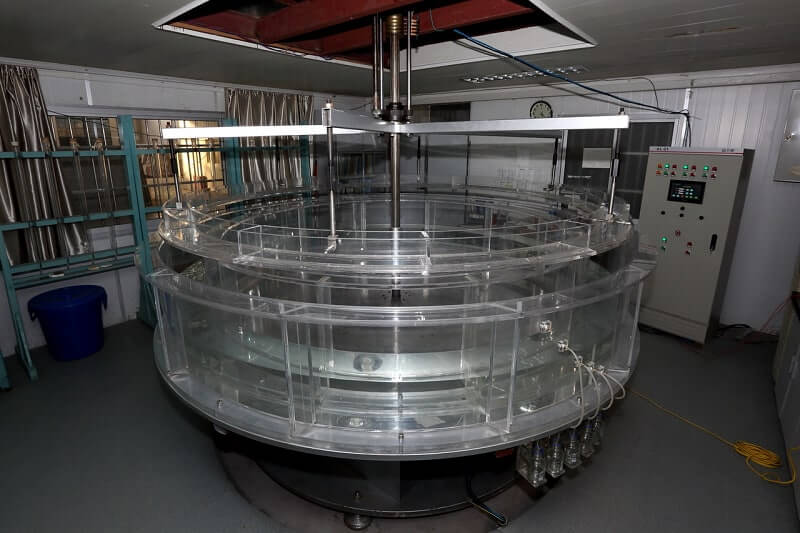
5. Environmental Sediment Laboratory
The Environmental Sediment Laboratory of the Experiment Centre has a D280 circular flume, equipped with advanced equipments such as Malvern 3000 Laser Diffraction Particle Size Analyser (RMB 380,000), Optima 7000 DV Inductively Coupled Plasma Emission Spectrometer (RMB 670,000), 7820A Gas Chromatograph (RMB 360,000), Hydra C Fully Automatic Mercury Analyser (RMB 270,000), TAS-990 Atomic Absorption Spectrophotometer (RMB 100,000) and so on. Spectrophotometer (100,000 yuan) and other advanced equipment. In the early 1980s, the university developed the first ring-shaped water tank in China, and the D280 ring-shaped water tank is the newest one developed by the institute, with the size of 280cm in outer diameter×30cm in width×50cm in height, equipped with a high-performance digital servo control system, a wireless remote-control system for dynamic collection of water samples, a wireless flow rate measurement system, and a wireless infrared sand-measuring system. This set of ring-type flume on the upper and lower disc rotation speed and direction can be arbitrarily adjusted, the upper disc height position can be dynamically adjusted up and down, on the upper and lower disc for the phase rotation movement in the ring groove to form the water flow. The ring-type flume system solves the problems of destroying flocs by pump stirring and slow settling speed of fine-grained sediment when studying viscous sediment with ordinary straight flume, etc. The ring-type flume can finely simulate the start-up flow rate of sediment, the settling speed of moving water, and the scouring rate of the on-site environment under the conditions of different flow speeds, different sand contents, and different salinity, which can provide experimental data for the study of harbour siltation back, reclamation of land, and evolution of the coastline and estuarine.
Experimental Centre for Water Resources and Civil Engineering Structures, Jiangning Scientific Research Experimental Base, Hohai University (189 Base)
Hohai University Jiangning Scientific Research Experimental Base (189 Base) is a school-level public experimental base constructed by Hohai University, which is located in the east of Ningdan Road, the south of Focheng West Road, and the west of Yinlong Road of Jiangning District, Nanjing City, occupying an area of 189 acres, with a total construction area of about 80,000 square metres.
The positioning of the base is to build a high level public experimental research platform at the school level which is fully functional, technologically advanced, large in scale, easy to cross disciplines and integrate results, easy to be scientifically managed and convenient to use, integrating the functions of water flow, structure, and simulation, with significant water conservancy and civil engineering characteristics, and influential in the international arena, so that the base will become a public The base will become a shared platform for scientific research and an advanced technology platform supporting the construction of double first-class disciplines, high-level scientific research and high-level talent training.
The base consists of three independent buildings, including water flow test hall, structural test hall and high-performance building, and currently there are three university-level platform centres, including Water Resources and Water Ecology Engineering Model Experiment Center, Water Resources and Civil Engineering Structures Experiment Center, and Water Resources Big Data Cloud Service Center.
The Experimental Centre for Water Resources and Civil Engineering Structures is mainly constructed on the basis of the structural test hall, with a total floor area of about 215,000 square meters, which mainly carries out scientific experimental researches on micro and micro-analysis and basic performance tests of concrete materials, performance tests of soils and rock-like materials, mechanical tests of materials, and static-dynamic performance tests of components and overall structures in the fields of water resources and civil engineering, and experimental research involves water conservancy engineering, Marine Engineering, Civil Engineering, Materials and Mechanics and other professional disciplines.
The Structural Experiment Centre of Water Resources and Civil Engineering is built on the basis of a structural test hall with a length of about 125m, a width of 56-64m, and a total building area of about 15,000m2 . The main hall of the structural test hall has a span of 27 metres and a height of 19 metres, equipped with a 30-tonne large truss truck with a lifting height of 13 metres. The secondary hall is a three-span, three-storey structure, each span is about 9 metres wide, the ground floor is 8 metres high, and the height of the second and third floors are both 5 metres.
In recent years, the university has completed the 3,000-tonne large-tonnage compression shear test system, concrete durability test system, mobile multi-point static loading system, large-scale high-pressure geotechnical material 3 material test system, reaction wall and proposed dynamic hybrid test system with the financial support from the 211 Project Construction Project, the National Advantageous Discipline Innovation Platform Construction Project, the Advantageous Discipline Construction Project of Jiangsu Province, and the Double First-class Construction Project, as well as the current The largest three-way six-degree-of-freedom simulated seismic underwater shaking table system in China.
Field Observation Research Base for Beach Conservation

The Beach Conservation Field Observation Research Base, located in Rizhao City, Shandong Province, was established in November 2019 by the Hohai University Coastal Remediation and Restoration Research Team after two years of preliminary preparation. Supported by the National Outstanding Youth Science Fund Project (51425901) and other research projects, the research base serves scientific research and technology development related to beach conservation and restoration in conjunction with the project of port shoreline retreat and sea restoration and remediation in the northern part of Rizhao Port in Haizhou Bay.

水利与土木工程结构实验中心简介V1.jpg)
